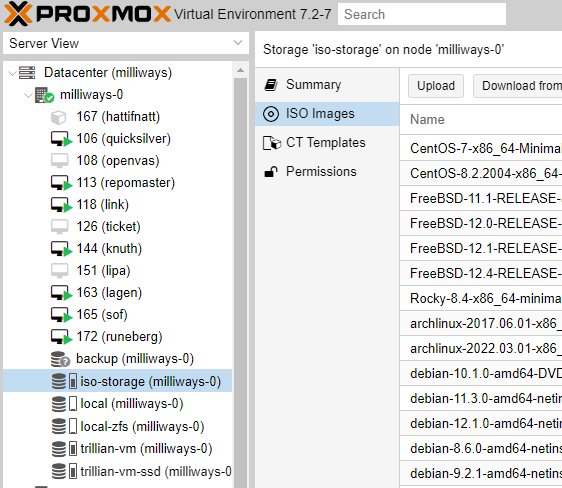Rootmanual:Proxmox: Skillnad mellan sidversioner
Tobbez (diskussion | bidrag) |
Hugo (diskussion | bidrag) |
||
| Rad 42: | Rad 42: | ||
== Storage == |
== Storage == |
||
=== Lägg till ny ISO att boota från === |
=== Lägg till ny ISO att boota från === |
||
Babelfish exoprterar iso-storage vis autofs till /mp/iso på alla lysatormaskiner som stödjer det. Mappen ska vara skrivbar för alla rötter, och läsbar av samtliga. |
|||
[[Fil:8C6MwuX.png]] |
|||
=== Configuring iSCSI on a storage server === |
=== Configuring iSCSI on a storage server === |
||
Nuvarande version från 1 oktober 2023 kl. 14.08
Instructions for managing and using our setup of Proxmox.
NOTE: If your cursor gets stuck in SPACE, 'use ctrl + alt + r' to release the cursor.
Creating a virtual machine
- Connect to the management interface of one of the compute nodes (e.g. https://proxar.lysator.liu.se:8006/ or https://proxer.lysator.liu.se:8006/) and log in.
- Click Create VM in the top right corner.
- General tab:
- Set a name for the VM
- Choose compute node for the VM to run on
- Add it to the appropriate resource pool
- OS tab: Pick Linux 3.X/2.6 Kernel (l26)
- CD/DVD tab: pick an ISO to install from.
- Hard disk tab:
- Change Bus/Device to VIRTIO
- Decide on a disk size. The disk image will use this much space on the storage server. If you are unsure, pick a smaller size and increase it later (10GB should be plenty for the typical VM).
- CPU tab: Allocate CPUs/cores as appropriate.
- Memory tab: allocate memory as appropriate.
- Network tab:
- Change Model to VirtIO (paravirtualized)
- If the VM will need a public IP
- Choose bridged mode
- Set Bridge to vmbr0
- If the VM will not need a public IP
- Choose NAT
- Confirm tab: Click Finish.
- Select the new VM in the tree view.
- Go to the Hardware tab
- Edit Display, and set Graphic card to SPICE.
- Go to the Options tab
- Edit "Start at boot" and set to enable if the machine should start automatically.
- Start the machine, and perform installation as usual.
Using the console
There are two options: SPICE, and Java. Don't use Java (unless you can't help it).
A prerequisite for using SPICE is the remote-viewer program (part of virt-manager).
To connect to a VM, first start the VM, and then click SPICE in the top right corner in the Proxmox management interface. This downloads a file that you pass on the command line to remote-viewer.
Storage
Lägg till ny ISO att boota från
Configuring iSCSI on a storage server
This section assumes debian.
- Follow the steps on http://zfsonlinux.org/debian.html
- Create a zfs pool:
zpool create ${POOLNAME} raidz2 /dev/sd{b..d}
- Create a block device in the zfs pool:
zfs create -V $SIZE ${POOLNAME}/vm-storage
- Install tgt:
aptitude install tgt- If your tgt version is older than 1:1.0.17-1.1, you need to manually install the init script:
mkdir tmp; cd tmp;wget http://ftp.se.debian.org/debian/pool/main/t/tgt/tgt_1.0.17-1.1_amd64.debar -x tgt_1.0.17-1.1_amd64.debtar xf data.tar.gzmv ./etc/init.d/tgt /etc/init.d/cd ..; rm -rf tmp
- Setup tgt to start automatically:
update-rc.d tgt defaults
- Create an iSCSI target:
tgtadm --lld iscsi --mode target --op new --tid 1 --targetname iqn.${YYYY}-${MM}.se.liu.lysator:${HOSTNAME}.vm-storage
- Add a LUN to the target, backed by the previously created block device:
tgtadm --lld iscsi --mode logicalunit --op new --tid 1 --lun 1 -b /filesystem/vm-storage
- Make the target available on the network:
tgtadm --lld iscsi --mode target --op bind --tid 1 -I 10.44.1.0/24
- Save the configuration:
tgt-admin --dump > /etc/tgt/targets.conf
Attaching new VM storage to the Proxmox cluster
- Go to Proxmox management interface.
- Click Datacenter in the treeview.
- Select the Storage tab.
- Click Add -> iSCSI
- Set the ID to
${STORAGE_SERVER_HOSTNAME}-vm-storage-iscsi(e.g.proxstore-vm-storage-iscsi). - Enter portal (the IP of the storage server)
- Select the desired iSCSI target from the target dropdown.
- Uncheck the checkbox for Use LUNs directly.
- Click add.
- Next, click Add -> LVM
- Set the ID to
${STORAGE_SERVER_HOSTNAME}-vm-storage-lvm(e.g.proxstore-vm-storage-lvm). - For Base storage, choose the iSCSI volume you added previously.
- Check the checkbox for Shared.
- Click Add.
Attaching new ISO storage
- Go to Proxmox management interface.
- Click Datacenter in the treeview.
- Select the Storage tab.
- Click Add -> NFS.
- Set the ID to
${STORAGE_SERVER_HOSTNAME}-iso-storage-nfs(e.g.proxstore-iso-storage-nfs). - Enter the IP of the storage server.
- Select the export from the Export dropdown.
- In the Content dropdown, select ISO and deselect Images.
- Set Max Backups to 0.
Flytta diskbild till ny lagringslösning
Om du vill flytta en disk från det interna zfs-filsystemet (local-zfs) till en av Ceph-poolerna (trillian-vm eller trillian-vm-ssd) så kan det göras via webbgränssnittet. Om diskbilden som ska flyttas ligger på en av Ceph-poolerna så blir processen mer invecklad. Ett exempel med en flytt från trillian-vm till trillian-vm-ssd (hur rag flyttades):
- Stoppa det VM vars disk ska flyttas.
- Se till så att det inte finns några snapshots.
- ssh:a in på servern som VM:et har körts på.
- Kör: /usr/bin/qemu-img create -f raw 'rbd:vm_ssd/vm-114-disk-1:mon_host=10.44.1.98;10.44.1.99;10.44.1.100:auth_supported=cephx:id=caspian:keyring=/etc/pve/priv/ceph/trillian-vm-ssd.keyring' 15G
- Kontrollera att den nya diskbilden finns med: rbd list vm_ssd -c /etc/ceph/ceph.conf -k /etc/pve/priv/ceph/trillian-vm-ssd.keyring --id caspian
- Flytta disken med: /usr/bin/qemu-img convert -p -n -f raw -O raw -t writeback 'rbd:vm/vm-114-disk-1:mon_host=10.44.1.98;10.44.1.99;10.44.1.100:auth_supported=cephx:id=caspian:keyring=/etc/pve/priv/ceph/trillian-vm.keyring:conf=/etc/ceph/ceph.conf' 'zeroinit:rbd:vm_ssd/vm-114-disk-1:mon_host=10.44.1.98;10.44.1.99;10.44.1.100:auth_supported=cephx:id=caspian:keyring=/etc/pve/priv/ceph/trillian-vm-ssd.keyring:conf=/etc/ceph/ceph.conf'
- Kontrollera diskbilden med: rbd info vm_ssd/vm-114-disk-1 -c /etc/ceph/ceph.conf -k /etc/pve/priv/ceph/trillian-vm-ssd.keyring --id caspian
- Konfigurations filen för VM:en måste redigeras för att den ska använda den nya diskbilden: nano /etc/pve/qemu-server/101.conf
- Nu kan du starta VM:en igen.
- Ta bort den gammla diskbilden när du känner dig säker.
